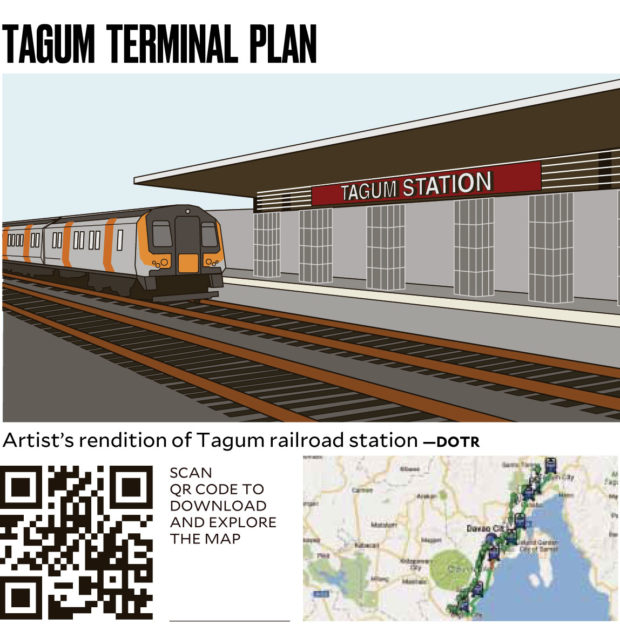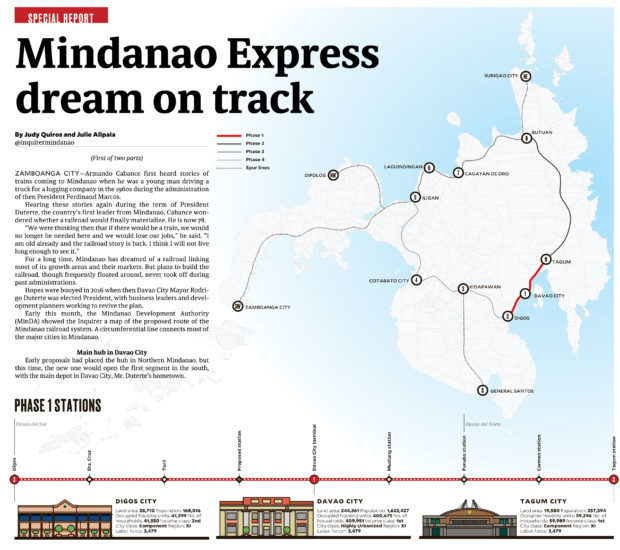Mindanao Express dream on track
(First of two parts)
ZAMBOANGA CITY — Armando Cabance first heard stories of trains coming to Mindanao when he was a young man driving a truck for a logging company in the 1960s during the administration of then President Ferdinand Marcos.
Hearing these stories again during the term of President Rodrigo Duterte, the country’s first leader from Mindanao, Cabance wondered whether a railroad would finally materialize. He is now 78.
“We were thinking then that if there would be a train, we would no longer be needed here and we would lose our jobs,” he said. “I am old already and the railroad story is back. I think I will not live long enough to see it.”
For a long time, Mindanao has dreamed of a railroad linking most of its growth areas and their markets. But plans to build the railroad, though frequently floated around, never took off during past administrations.
Hopes were buoyed in 2016 when then Davao City Mayor Rodrigo Duterte was elected President, with business leaders and development planners working to revive the plan.
Early this month, the Mindanao Development Authority
(MinDA) showed the Inquirer a map of the proposed route of the Mindanao railroad system. A circumferential line connects most of the major cities in Mindanao.
Main hub in Davao City
Early proposals had placed the hub in Northern Mindanao, but this time, the new one would open the first segment in the south, with the main depot in Davao City, the President’s hometown.
On the map shown by MinDA, the rail line would start from Digos City in Davao del Sur province and run up to Tagum City in Davao del Norte province. It would run all the way to Butuan City (Agusan del Norte province), leading to the cities of Cagayan de Oro (Misamis Oriental province) and Iligan (Lanao del Norte province).
The line would cross towns in the provinces of Lanao del Norte and Lanao del Sur, move on to Cotabato City and down to Kidapawan City in North Cotabato province.
Heart shape, spur lines
The final stretch would end where the rail line started in Digos, completing a heart-shaped loop.
To reach other cities outside the loop, spur lines would branch out from the main railroad.
These would include the 141-kilometer spur line connecting Kidapawan to General Santos City (South Cotabato province); another 109-km line linking Butuan to Surigao City (Surigao del Norte province); two more spur lines joining Iligan and Dipolog City in Zamboanga del Norte province (114 km); and a 338-km line connecting Dipolog to Zamboanga City.
Romeo Montenegro, MinDA deputy director for operations, said that except for its first segment, the rest of the rail line was still a plan.
No study has yet been made on the viability of the rest of the segments in the loop, he said.
Montenegro gave assurance, however, that the Digos-Tagum segment was one of the priority projects under the Duterte administration’s flagship infrastructure program, “Build, Build, Build.”
The detailed engineering design of this segment has been targeted to be finished in June, after which bidding and procurement of materials could start.
 Barring major roadblocks, construction could begin in September and be completed by the second quarter of 2021, a year before the President’s term ends.
Barring major roadblocks, construction could begin in September and be completed by the second quarter of 2021, a year before the President’s term ends.
According to Montenegro, the Tagum-Davao-Digos segment approved by the Department of Transportation (DOTr) has a provision for the expansion of tracks and “electrification” that could be covered by the Butuan-Tagum segment (Phase IB).
The MinDA secretary, Abul Khayr Alonto, said a high-speed train running through a 2,000-km railroad across the island, estimated to cost P450 billion, would answer the age-old clamor among business and industry leaders for an efficient transportation system for bringing various goods and services from Mindanao to major markets.
Unfortunately, a high-speed train is not even on the drawing board right now.
Single track, 16 kph
The plan approved by the DOTr, which covers only the first Digos-Tagum segment, still shows a single-track, diesel-powered locomotive to service the 102-km route.
The locomotive would consist of six passenger-train sets with five cars per set and three spare cars. Its frequency would be up to six trains per hour.
Each train would run at a speed of 16 km per hour, cutting travel time between Tagum and Digos from 3.5 hours to 1.3 hours, Montenegro said. The first segment costs P36 billion.
The single-track, diesel-powered locomotive, however, was not what MinDA had proposed.
Together with the Regional Development Council in Southern Mindanao, MinDA had originally sought a two-track, electric-powered rail system.
“For us, the difference between a single-lane, diesel-powered locomotive and a two-lane, electric train is the speed,” Montenegro said. “But there’s also an important matter about the cost.”
The cost of the DOTr-approved plan would only be P36 billion, which could almost double if proponents would push through with the original plan.
A map of the trial alignment for the Tagum-Digos segment shows the line’s first station on MacArthur Highway near Pedro Balasa Elementary School in Digos.
It would cross rice fields and creeks before its next stop, Santa Cruz station. It would then move on to Toril station near the Bayabas-Eden Road and stop at its main Davao hub.
The journey would continue through the rest of the stations in Mudiang, Panabo and Carmen and stopping near La Filipina airstrip at Tagum’s Barangay Mangkilam.
Subject to change
This alignment, however, is still subject to change, depending on the results of the detailed engineering design, according to Montenegro.
The entire project, in fact, is tentative as proponents still want to push through with the original plan for an electric train system during a recent meeting.
MinDA is prepared to resubmit and pursue the original proposal, Montenegro said.
“If we push through with the two-track, electrified train system, the timeline will change,” he said.
“It will mean there would be changes in the costs. But even if it would lengthen the timeline, it would all be worth it if we get what we had originally aimed for,” Montenegro said.
As MinDA takes over the railroad project from the DOTr, Montenegro said MinDA Secretary Alonto would have to meet with Transportation Secretary Arthur Tugade and officials of the National Economic and Development Authority to steer the discussions back to MinDA’s original proposal.















